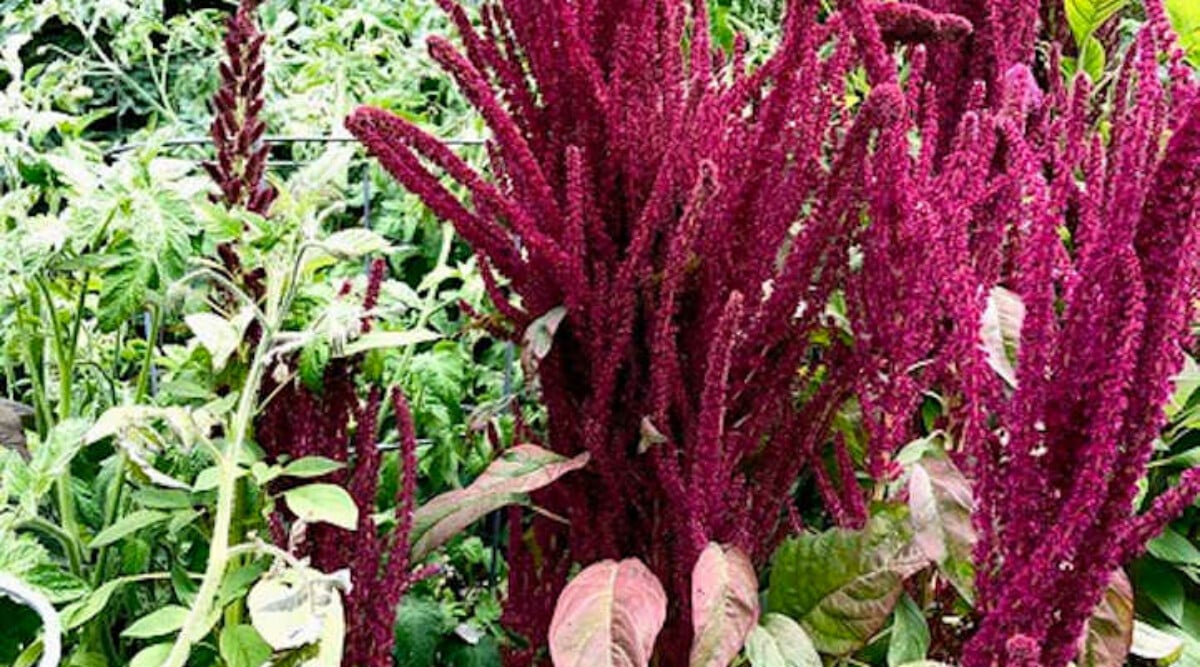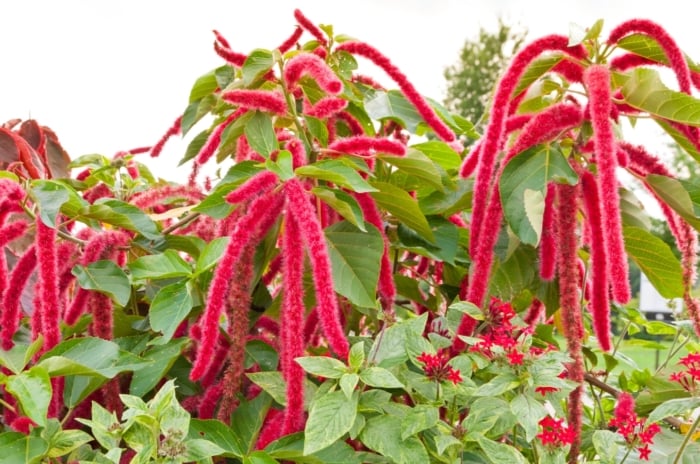How to Plant, Grow, and Care for Amaranth
Ancient grains are becoming popular again, and by growing amaranth you're able to supply your own. Find out how in this complete guide.

Contents
You may have heard of the ancient grain amaranth, an amazing food similar to quinoa and packed with protein. This crop has been cultivated for thousands of years in America and is valued as a superfood throughout the world. Plus, it’s also easy to grow in your own garden.
Many varieties of amaranth plants can grow to towering heights, up to 10 feet tall. Its stalk is a popular trellis for vine plants such as beans and peas to climb. The grain also provides food for birds and the flowers are adored by bees.
If you want to try growing this easy and carefree crop for yourself, follow this guide.
Plant Overview
- Plant Type: Annual
- Family: Amaranthaceae
- Genus: Amaranthus
- Species: Amaranthus hypochondriacus, Amaranthus cruentus
- Exposure: Full sun
- Height: 2′-8′
- Watering Requirements: Moderate
- Maintenance: Moderate
- Soil Type: Rich, well-draining
What is Amaranth?
There are many varieties of amaranth plants, yet the ones commonly grown for grain are the prince’s feather (Amaranthus hypochondriacus) and red amaranth (Amaranthus cruentus). Other common names include red-rooted pigweed, purple amaranth, and velvet flower.
Amaranthus originates largely from Central America and North America, but there are many amaranth varieties found around the world. Species vary in height but are quite tall, growing two to eight feet or more in height.
The stalks that form from the main taproot are sturdy and tough. The leaves are broad, with long, narrow, bushy flowers that range in color from burgundy to golden yellow or green. Tiny seeds develop on the flower head, which ranges from four to twelve inches long.
Once planted, amaranth seeds will germinate in less than two weeks. Seedlings will appear to grow slowly. When the plant reaches a foot tall, it will start to grow rapidly and produce beautiful flowers. The grains will be ready to harvest in the fall once the flowers are brown and dry.
Uses
Amaranth is a highly nutritious food with gluten-free seeds packed with protein. The seeds are often referred to as grains and can be ground into flour, popped, pressed into an oil, or cooked similarly to rice.
The young tender leaves of Amaranthus cruentus are edible and can be used as a replacement for leafy greens. Mature leaves can be sauteed.
If you are into fresh sprouts, the tiny seeds can be sprouted and enjoyed as microgreens. Some have used the plant as a dye, in herbal shampoo, or even as a nourishing crop for their livestock.
Varieties
There are many other fun varieties of Amaranthus to grow in your garden. There are the long flowing flowers of coral fountain (Amaranthus caudatus), the multicolored Joseph’s coat (Amaranthus tricolor), or the large flowers of the elephant head (Amaranthus gangeticus). It is easy to get lost when you search all the amazing heirloom varieties.
Planting
The best time of year to grow amaranth plants outdoors is in mid-spring to early summer. If you want to start earlier, plant the seed indoors four to six weeks before the last frost has passed in your region.
Amaranth grows easily in many soil types but thrives in well-drained, fertile, loamy soil. Plant directly into the ground in rows, raised beds, or large containers (10-18 inches in diameter) that receive lots of sunlight. For plants started inside, transplant once your last frost date has passed.
Many choose to grow amaranth near the border or towards the back of the garden. It is a great companion plant and can be incorporated into the three sisters‘ vegetable guild of corn, beans, and squash. Try using amaranth in place of the corn and watch the beans climb up the amaranth stalks!
How to Grow
Amaranth needs little maintenance and is relatively free of pests and diseases. The more space and air circulation they get in the garden, the larger the plants.
Light
Amaranth needs full sunlight to thrive. Choose a position in your garden that receives a minimum of six hours of sunlight per day, preferably closer to eight hours. If the plant does not receive enough sun, the stalks will be weak and the plant will struggle to flower.
Water
Amaranth is a drought-tolerant plant. Watering is most important during the early stages of growth, with much less frequent watering required once the plants mature.
Keep the soil lightly moist after sowing. Once plants are two to four inches tall, water once or twice per week, depending on environmental conditions. Amaranth is water efficient and will survive without being watered for a few weeks.
The best time to water amaranth is in the early morning or late afternoon. Focus the water towards the base of the plant on the roots, using a directed sprayer, a soaker hose, or drip irrigation. Avoid watering the flowers and grain.
Soil
Amaranth loves rich well-drained soil. It does tolerate poor conditions, but may not be as vigorous in dense clay soils. Consider adding compost and peat moss to increase the organic material and drainage. The optimum pH level range is 6.0-7.5.
Temperature & Humidity
The amaranth USDA Zone ranges from 3-11. The ideal temperature for germination is 65-85F. When young, this crop is not tolerant of cold temperatures and is susceptible to spring frosts, whereas mature plants can tolerate the first frost of the fall.
This plant loves warm temperatures and can tolerate heat up to 95-100F.
Fertilizing
Amaranth plants are low maintenance, and fertilization is only necessary if you have poor growing conditions.
Add fertilizer like fish emulsion or worm castings when you first plant the amaranth seeds to give them an extra boost. Alternately, work some composted manure into the bed and skip fertilizing entirely. Nitrogen-heavy fertilizers are not recommended.
Maintenance
Pruning is not necessary for this annual plant. But, to promote more flowers, you can trim back the top half of the plant when it’s still young. This will encourage branching, producing more flower heads.
Tall varieties may need additional support, as they can bend or break in high winds or storms. Place a trellis, netting, or individual stakes at the time of planting and gently tie the stalk of the amaranth to the support as it grows.
Propagation
Amaranthus is propagated by seed. The seeds are incredibly tiny. Broadcast them and cover them lightly with soil, or sow two seeds per shallow hole a quarter-inch deep and about four inches apart. Keep soil moist during germination.
Thin young plants to 18 inches apart when their first true leaf has sprouted. The amaranth seeds fall easily from the flowers and plants themselves, so you can expect this annual to pop up every year.
Harvesting
The beautiful blooms can be enjoyed as cut flowers, but we also want to harvest amaranth for food, enjoying the tasty greens and nutritious seeds.
Young leaves are ready for harvesting 25-40 days after planting. You can harvest the entire top half of the amaranth plant for the young leaves, and the stem will regrow with multiple stalks. Alternately, pluck off the young leaves on the top half of the amaranth. Mature leaves are tougher and not as desirable.
To harvest for amaranth seed or grain, wait until the flowers are brown and dry in the fall. You can even wait until after the first hard frost to harvest the seeds. Cut the entire flower stalk and leave in a dry place for a few weeks or place in a paper bag.
Storing
The edible leaves are best eaten fresh and are considered highly perishable. Amaranth leaves will last a few days in the fridge if you wrap them in damp paper towels and store them in a plastic storage bag. You can also parboil the leaves, drain them, and put them in the freezer for longer storage.
To retrieve the seeds from the flowers, use your hands to rub out the seeds, or shake seeds loose in a paper bag or clean pillowcase. To remove finer chaff, use your breath to gently blow it off or slowly exchange seeds in a slow waterfall motion between two bowls and let the finer chaff fly out in the breeze.
Store seeds in an airtight container and place them in the fridge. They will last six to eight months.
Common Problems
Amaranthus is a relatively pest-free plant that grows vigorously in the garden. Yet you might find that your plant is not growing as tall and strong as you’d like, or something is nibbling the leaves. Let’s discuss how to troubleshoot some of these potential problems.
Small Plants
If your crops are in the shade or densely planted, you will notice that your amaranth will be smaller. Adjust the available sunlight if other plants are shading your amaranth or thin out the plants to 18 inches apart to provide proper air circulation.
Temperature may also be a factor in growing issues. Amaranth loves hot sunny weather. If you are located in a cooler region, plant in the hottest part of your garden and use rock mulch.
Pests
Visible damage to leaves may be caused by amaranthus stem weevils. Their larvae chew on the roots. Growth will be stunted and stalks may start to twist. Prune out infected leaves and remove any of the larvae that you find. If the damage is severe, you will need to remove the plant completely. Neem oil has had some effect in reducing numbers.
Tarnished plant bugs will attack the seeds and flowers by sucking out the liquid. This diminishes seed production. Apply the organic pesticide pyrethrin to eradicate the infestation. When plants are young, floating row covers can keep them at bay.
Flea beetles love seedlings. Floating row covers are a great preventative measure against these pests. If the infestation is mild, apply diatomaceous earth or kaolin clay. For severe infestations, use pyrethrin.
Diseases
There aren’t many diseases threatening the resilient amaranth. The main concern is damping off, which can occur during the early stages of growth.
Plants may die off suddenly from too much nitrogen or overwatering. To prevent this, limit the use of fertilizer and allow the soil to dry between waterings. You can also thin out the seedlings to encourage more airflow.
Root rot can also impact the growth of your amaranth. This is typically caused by overly wet conditions, prevented by ensuring your soil is well-draining. Plants currently suffering from severe root rot likely won’t recover. If the plant dies, remove it and do not compost the roots to avoid spreading fungal pathogens.
FAQs
Q: Why is amaranth banned in the US?
A: Growing amaranth is not banned. Instead, the amaranth dye added to commercial food products is banned. The plants are very commonly grown in gardens around the US.
Q: How long does it take to grow amaranth?
A: It takes 90-150 days to grow amaranth, depending on the variety.
Final Thoughts
Amaranth is a fun and effortless plant for your garden. Not only does it have stunning flowers, but it also provides unique food for the family.







